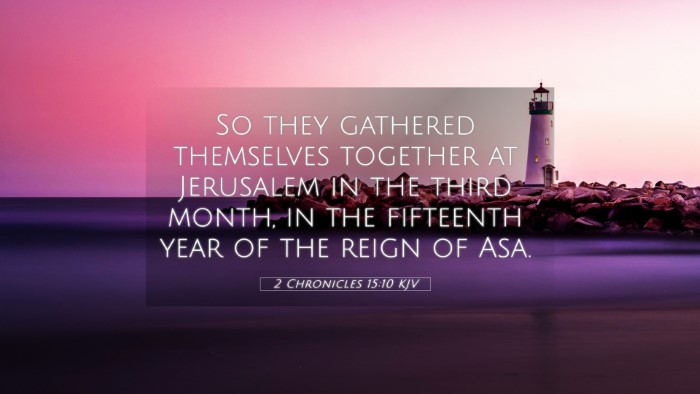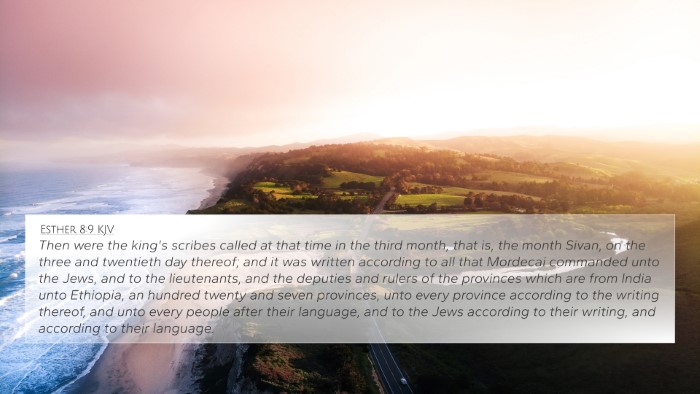Understanding 2 Chronicles 15:10
Verse: "So they gathered together at Jerusalem in the third month of the fifteenth year of the reign of Asa." (2 Chronicles 15:10, NKJV)
Summary of the Biblical Context
The book of 2 Chronicles focuses heavily on the reigns of the kings of Judah, particularly looking at their fidelity to God and the resulting prosperity or adversity in the nation. In this specific passage, the focus is on King Asa, who was noted for his religious reforms and efforts to foster national repentance and a return to true worship.
Commentary Insights
Insights from various public domain commentaries provide a deeper understanding:
-
Matthew Henry:
Matthew Henry emphasizes Asa's commitment to seeking after God which necessitated collective action among the people of Judah. He points out that gathering together is a sign of unity in worship and a shared desire for spiritual renewal. Asa's reign is characterized by a move away from idolatry and towards the worship of Yahweh, highlighting a transition of the nation towards sincerity in faith.
-
Albert Barnes:
Barnes adds that the timing of the gathering (the third month) is significant and reflects a time of preparation and readiness. He draws connections between this event and the covenant renewal seen in earlier chapters, suggesting that this assembly indicates a fulfillment of God’s promises when His people gather in His name. Barnes sees this as both a historical and spiritual event that set the tone for Asa’s reformation efforts.
-
Adam Clarke:
Clarke notes that the fifteenth year of Asa's reign corresponds to a critical period of establishing religious reforms. He emphasizes the importance of communal worship and national repentance. Clarke suggests this gathering signifies the people's response to Asa’s reforms and is a necessary step towards reinstating covenant loyalty with God.
Cross-References and Thematic Connections
This verse can be linked to several other scripture references that provide thematic parallels and highlight common messages, particularly regarding corporate worship, repentance, and divine promise. Here are some notable cross-references:
- 2 Chronicles 7:14: "If My people who are called by My name will humble themselves, and pray, and seek My face, and turn from their wicked ways..." - A call to collective humility and seeking God.
- 2 Chronicles 15:1-2: Prior verses highlight the coming of the Spirit of God upon Azariah, signaling His presence and the need for the people to turn back to God.
- 1 Kings 18:21: Elijah’s call for the people to choose whom they will serve, paralleling Asa’s efforts to redirect people from idols back to worshiping Yahweh.
- Nehemiah 8:1-3: Another instance where the people gathered to hear the Word of God, reflecting a corporate commitment to spiritual growth.
- James 4:8: "Draw near to God, and He will draw near to you..." - A New Testament parallel emphasizing the necessity of seeking God with sincerity.
- Acts 15:25-26: The early church gathered to discuss crucial matters, much like Asa’s assembly, showing the continuity of communal faith across the Testaments.
- Hebrews 10:24-25: "And let us consider one another in order to stir up love and good works, not forsaking the assembling of ourselves together..." - A call to gathering in worship in the New Covenant.
Practical Applications
- Unity in Purpose: The gathering of the people signifies the importance of coming together with a shared goal of seeking God.
- Collective Repentance: Asa’s efforts remind us of the need for collective acknowledgment of sin and a desire to turn back to God.
- Covenantal Faithfulness: There is a stress on remaining faithful to God and His commands as a community.
- Spiritual Renewal: The act of gathering represents a moment of renewal both personally and collectively, pertinent for congregations today.
Conclusion
2 Chronicles 15:10 reveals significant insights about the importance of gathering for communal worship and the spiritual renewal of a nation. The commentaries highlight the context of Asa’s reign along with inter-Biblical themes that serve as a guide for modern believers. In pursuing a deeper biblical understanding, utilizing tools for cross-referencing can illuminate connections between scripture, enriching our understanding and application of God’s Word.



